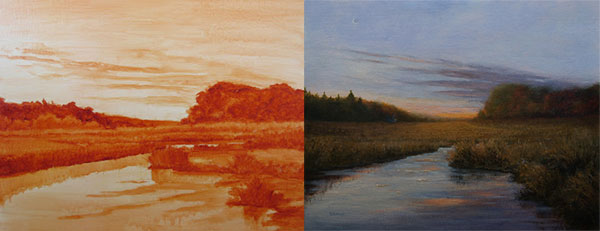Mixing Color Strings
Color string–prepared paint blobs of a given hue mixed with a palette knife in steps from light to dark. It saves time when you’re painting observationally.
Advantages: It uses less palette surface than free mixing, you can mix generous batches with your palette knife (leaving your brush to be used just for paint application), and it saves times in the long run–you don’t have to keep remixing colors.
Mixing 4-5 value steps should be enough to get the values you need. Have 2-3 light steps, 2-3 shadow steps and blend anything else you need.
Gamut Mapping
Entire group of possible colors for a painting: gamut. (Polygon superimposed over color wheel.) The colors you use in a composition are as important as the colors you leave out.

Composed of subjective primaries (corners), subjective neutrals (the mixture midway between all extremes).
The secondaries of a triadic gamut will be lower in chroma than the primaries. (Halfway point along each side of the triangle is closer to the gray center–more neutral.) This is called saturation cost.
Creating Gamut Masks:
Cut a mask of a gamut shape and place it atop a color wheel. Move it around to create new schemes.
You can choose exactly what colors you want. You can invent and preview different schemes you might not have considered. You’ll have what you need to create a color scheme, and it looks awesome.
Shapes of Color Schemes
Gamuts are polygons. Can be triangles, diamonds, or squares. Triangles are most common shape. Useful one: equilateral triangle shifted to one side of the wheel without overlapping the center at all–an atmospheric triad

Complementary gamut–long diamond stretching across the middle of the wheel.
Mood and accent scheme–most of piece in one part of environment with a separate shape in a complementary color for accent.
Mixing a Controlled Gamut
choose your color, and then make color strings that you’ll use for your entire painting. Premixing helps you stay within your gamut.
Once you’ve mixed your colors and made your strings, remove the tube colors from your palette–they’re not in your gamut.
Color Scripting
In sequential art (like a movie, illustrated book, graphic novel), no color scheme stands alone. Everything needs to flow with what’s around it.
You can plan your color script with the aid of a color wheel and gamut masks. A sudden gamut change signals a change to the audience.
 Here’s color scripting for the movie “Cloudy With A Chance of Meatballs.”
Here’s color scripting for the movie “Cloudy With A Chance of Meatballs.”

